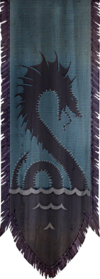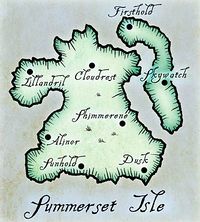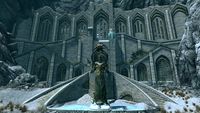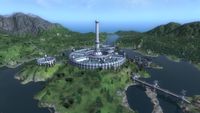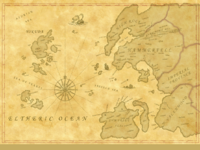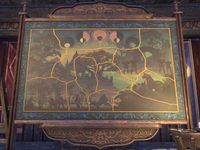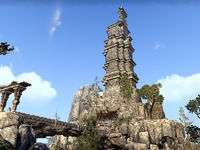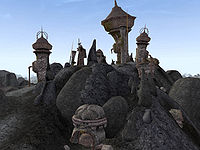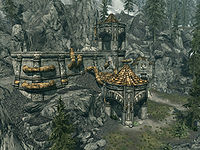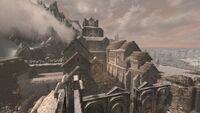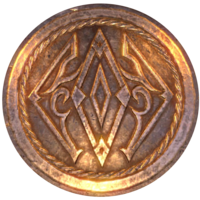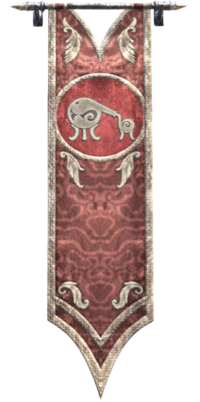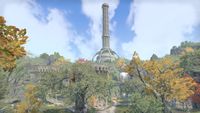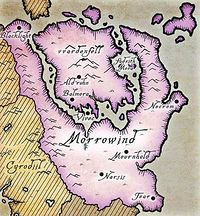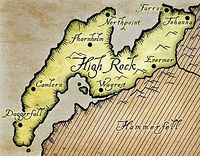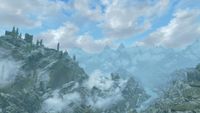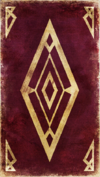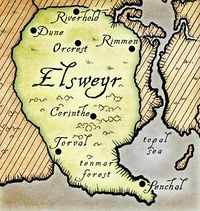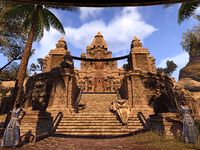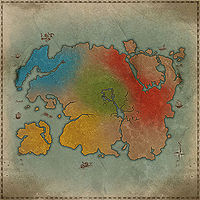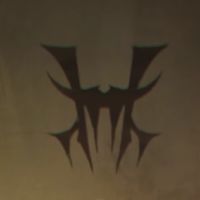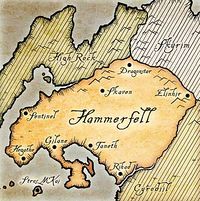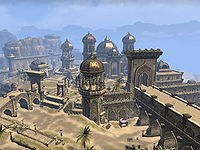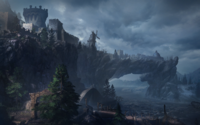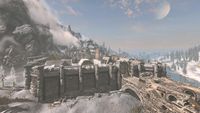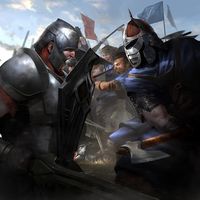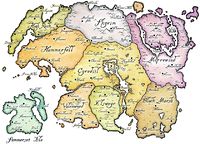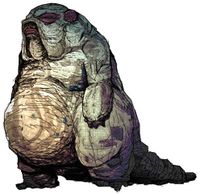Lore:Empires
Contents
- 1 Kingdom of Pyandonea
- 2 Kingdom of Alinor
- 3 Snow Elf Empire
- 4 Ayleid Empire
- 5 Lefthand Empire
- 6 Sixteen Kingdoms of Elsweyr
- 7 Nedic Kingdoms
- 8 Dwemer Kingdoms
- 9 Ysgramor Dynasty
- 10 Camoran Dynasty
- 11 Kingdom of Orsinium
- 12 Yokudan Empire
- 13 First Empire of the Nords
- 14 Alessian Empire
- 15 Direnni Hegemony
- 16 Kingdom of Resdayn
- 17 Kingdoms of High Rock
- 18 Reachmen Kingdoms
- 19 Second Empire
- 20 Elsweyr Confederacy
- 21 Empire of Cyrodiil
- 22 Longhouse Dynasty
- 23 Kingdom of Hammerfell
- 24 Kingdoms of Skyrim
- 25 Third Empire
- 26 Kingdom of Black Marsh
- 27 Coral Kingdoms of Thras
- 28 Tiger-Dragon's Empire
- 29 Notes
- 30 References
Numerous empires, kingdoms and dynasties have risen and fallen in Tamriel and beyond. The largest and most notable empire in history was the Third Empire established by Tiber Septim. An empire can be defined as a centralized state that extends political or military control over many territories. The processes by which empires rose on Nirn depended on their goals and circumstances and were rarely the same across different empires. Some reasons included military conquest, political alliances or religious motivation.
The following is an approximate chronological account of all the notable empires and kingdoms that have existed on Nirn.
Kingdom of Pyandonea[edit]
Very little is know about the Kingdom of Pyandonea, one of the first ruling kingdoms on Nirn, other than scant details discerned from interactions with the Maormer, hearsay and legends. According to long-untranslated tapestries within the Crystal Tower, the kingdom was established in the Early Merethic Era after a phenomenally wealthy Aldmer nobleman named Orgnum attempted to instigate a rebellion against the rulers of Aldmeris - the ancestral homeland of the Aldmer. The coup failed and Orgnum and several other clans was exiled from Aldmeris to an island continent surrounded by an impenetrable mist, known as Pyandonea.[1][2][3]
It was on Pyandonea that Orgnum styled himself as king and "Voice of the Free Maormer People" over the other exiled clans most loyal to him. He then began marshalling his organized and well-disciplined forces in preparation for a triumphant return.[4][1] Not all Maormer remained part of his kingdom and over time some breakaway clans descended into near-barbarism.[5]
The veil of mist surrounding Pyandonea prevented Orgnum from ever disturbing Aldmeris, but that changed when the Aldmer migrated from their homeland and settled on the Summerset Isles, located north of Pyandonea.[2] The Kingdom of Pyandonea made countless attempts to invade the Summerset Isle backed by a strong revanchist policy.[1] For almost every year of the First and Second eras, Pyandonean forces led by King Orgnum harassed the coastlines of Summerset.[2][6] They were also known to have pushed further north, as well, and harassed the coastline of Valenwood during the Interregnum.[7]
The extent of the kingdom's territory outside of the island continent remains unknown, but they have been known to sign treaties with independent states. One such treaty was with Khenarthi's Roost in the mid-Second Era whereby the Maormer Enforcement Squadrons agreed to not perpetrate unprovoked acts of aggression towards merchant ships in or around the port city of Mistral, in return for fifteen percent of all registry fees and excises.[8] Orgnum has supposedly ruled the kingdom as its sole monarch since its founding in the Merethic Era until at least 3E 110, partly due to his purported status as "a deathless wizard" who grows more youthful by the century.[2]
Kingdom of Alinor[edit]
The Kingdom of Alinor is one of the earliest known ruling kingdoms on Nirn. It can be traced backed to the Early Merethic Era when the Aldmer fled Aldmeris and made landfall on the Summerset Isles in southwestern Tamriel. Firsthold was one of the earliest settlements in the kingdom, established by High Lord Torinaan, but soon other kinholds followed his example and prospered. These sophisticated, literate and technologically advanced elves displaced the native beastfolk and built the Crystal Tower - firmly establishing their empire. From Alinor ruled an unknown High King, whose dynasty was said to extend unbroken until at least the mid-Second Era..
The mysterious Scrolls of Praxis played an enormous role in Aldmeri monarchic rule. According to the traditions of Elven Ceremoniarchy, every decision a ruler made must be based on the precedents laid down in the scrolls. Such is their import that heirs to the throne were required to study Altmeri Regal Praxis and Ceremoniarchy under the Sapiarchs for a requisite 3,555 days prior to receiving the crown. The coronation itself supposedly involved an eighty-eight day liturgy recited by the monarch themselves. When a new monarch inherited the throne, they traveled to Tanzelwil, vast ruins on Auridon to commune with the dead and seek their approval to the throne. Afterward, the College of Sapiarchs serve as a powerful resource to the Throne of Alinor, offering advice and counsel when called upon.
Provincial rulers were known as High Kinlords and Kinladys, such as High Kinlady Estre of Skywatch or High Kinlord Rilis of Firsthold. Other offices of power include Canonreeve - similar to a mayor, its an official title given to diplomats and bureaucrats who administer county seats.
Firsthold later became the staging ground for several naval expeditions, by order of the Crystal Tower. Three ships were chosen to explore uncharted territories and find a way back to Aldmeris. Although only one ship returned, they successfully mapped numerous coastlines of mainland Tamriel, setting the stage for the eventual Aldmeri diaspora. According to some legends, the Aldmer didn't stop at mere naval exploration. A mythical order known as the Sun Birds of Alinor attempted extra-planetary expeditions to Aetherius.
From the ancient wellspring of Summerset, the Aldmer eventually split along cultural and religious lines resulting in the plethora of distinct Elven races we know of today. As various groups of Elves began to emigrate from Summerset, some (such as the Ayleids) continued to swear fealty to the High King of Alinor. Others, such as the Direnni clan, became independent from the kingdom and sought their own path. Arguabally one of the most notable schisms in the kingdom was the first recorded large-scale religious sect espousing Daedra worship by the so-called prophet Veloth. When the Sapiarchs of Alinor prohibited this schism, Veloth led the clans loyal to him out of the Isles and across the seas to the far side of Tamriel. Another notable schism in the kingdom was when the Aldmer began to move away from pure, ecumenical ancestor worship towards ancestor worship of the elite. A group of dissident elders, known as the Psijic Order, rejected this change and left Summerset to settle on the nearby island of Artaeum to continue practicing the "Old Ways of Aldmeris". By the Late Merethic Era numerous groups of elves had left the kingdom to settle other parts of Tamriel and tribute-lands, such as Cyrod under the Ayleids, detached themselves from the kingdom completely. The Aldmer that remained on Summerset became known as the Altmer and in the following eras became largely removed from the conflicts and rise and fall of empires on mainland Tamriel.
One of the main threats the kingdom faced was the Kingdom of Pyandonea to the south. King Orgnum made countless attempts to invade the Summerset Isle backed by a strong revanchist policy. For almost every year of the First and Second eras, Pyandonean forces harassed the coastlines of Summerset. The Kingdom of Alinor was forced to build a great navy to defend itself, which resulted in the Altmer excelling in naval combat. The Royal Navy keeps the sea lanes as clear as possible and serves as a deterrent to external threats.
One of the few instances the Kingdom of Alinor involved itself with external conflicts pre-Second Era was when Admiral Bendu Olo proclaimed his intent to punish Thras for the Thrassian Plague in 1E 2241. In response, the shipyards in Alinor worked in concert with other nations to build a fleet and attack Thras. Additionally, the great warlock Syrabane lent aid given his prowess in arcane naval warfare.
The Aldmeri Dominion[edit]
The Kingdom of Alinor allied with its neighbors to form the First and Second Aldmeri Dominion during the Second Era. While the justifications for each incarnation differed, the objective was the same objective: to reassert Elven dominance over Tamriel. The First Dominion saw the Summerset Isles allied with the Bosmer of Camoran Dynasty and the Khajiit of Elsweyr Confederacy in the Elden Accord. To that end, the kingdom fought in the Three Banners War against the Daggerfall Covenant and Ebonheart Pact for control of mainland Tamriel.
The Second Dominion was formed in 2E 830 when the Kingdom of Alinor conquered Valenwood over a dynastic dispute. When the heirs of the Camoran Dynasty sought to capture Valenwood's throne, a faction of Bosmer attempted to make peace with their enemies in the Colovian Estates by offering part of the Valenwood territory in exchange for the faction's own claimant. The Kingdom of Alinor, upon hearing of this, invaded Valenwood, citing a stewardship clause in a thousand-year-old treaty between their nations. The Altmer established the Thalmor as the new government in Valenwood. Over the next several years, the Thalmor strengthened their hold on Valenwood and Bosmer tribes continued to skirmish with the Colovian Estates. Meanwhile, Tiber Septim rose to power in Cyrodiil and began his conquest of Tamriel with the Tiber War. The nascent Third Empire expanded and encroached on Dominion territory, forcing the Bosmer attacks to subside. Despite their military setbacks on land, Alinor's Royal Navy was considerably more powerful and steadfastly held the southern waters from the Cape of the Blue Divide to the Topal Bay. The catastrophic use of the Numidium ended the long confrontation in 2E 896, resulting in the surrender of the Kingdom of Alinor them being absorbed into the Empire.
A Third Dominion was established centuries later in 4E 22, in the aftermath of the Oblivion Crisis. By painting themselves as the as the saviors of the Summerset Isles, the Thalmor solidified their position and seized total control of the Summerset Isles. They abolished the monarchy across the Summerset Isles, ending one of the oldest kingdoms on Nirn. Seven years later, a Thalmor-backed coup overthrew Valenwood's government. Alinor and Valenwood proclaimed a union independent of the Empire, and the Aldmeri Dominion was reborn. Elsweyr split into the kingdoms of Anequina and Pelletine in 4E 115 and subsequently became client states of the Dominion.
Snow Elf Empire[edit]
Little is known about the empire of the Snow Elves other than what has been derived from scholarly works, legends and myths. Given that the religious pantheon of the Snow Elves overlaps significantly with the Aldmeri pantheon (which itself was first established on the Summerset Isles) suggests the Snow Elves split from their Aldmer brethren on Summerset in the Middle Merethic Era.[9][10] When they arrived in the land known today as Skyrim, they founded their empire and prospered greatly, and according to some scholars possessed a degree of sophistication and power unparalleled in Tamriel at that time.[11] Its unknown the extent to which their borders reached, as virtually no Snow Elf structures or cities remain in Skyrim, except one that was discovered underground near the city of Riften.
When the Atmorans migrated to their lands in the Late Merethic Era, the two races live in relative peace for some time, and the Atmorans thrived, summoning more of their kin from Atmora to build the city of Saarthal.[12] The peace didn't last and soon the Snow Elves found themselves in constant conflict.[9] The catalyst that would lead to the destruction of the Snow Elf Empire was the infamous Night of Tears. Why the elves instigated the massacre of Saarthal is disputed; attributed motives include fear, religious and military provocations, territorial disputes, and a desire to possess an ancient power the humans had uncovered.[12][11]
The elves drove the Atmoran survivors from their shores, but Ysgramor soon returned with his Five Hundred Companions and began his onslaught on the elven empire. It is unknown how long the conflict, known as the Return, lasted but by the beginning of the First Era the elves built the Chantry of Auri-El in the isolated Forgotten Vale to serve as the epicenter of their religion.[nb 1] Whatever resistance the elves put up was no match for the Atmoran horde and the war continued in their favor.[9] After wiping out organized elven resistance in Skyrim, the Nordic armies sought their enemy out on the island of Solstheim. The elves made a last stand in the Battle of the Moesring: after an intense battle, their leader, the Snow Prince, was killed, and the empire of the Snow Elves was destroyed.[13] The survivors fled underground to hide and those who remained on the surface were exterminated in the following decades, even as late as 1E 140.[14][15]
Around three centuries passed until the Dwemer arrived in Skyrim sometime after 1E 420.[16][17]. They Dwemer established their own kingdom under Skyrim itself, and many Snow Elves turned to their underground brethren for help.[18][19] The Dwemer offered to provide them a haven, but forced their wards into servitude, only allowing them to consume a toxic fungus which rendered them blind. Over time, the servants became slaves, but despite this the Snow Elves would rise up against their Dwarven Masters waging the unseen War of the Crag, which was at a standstill for centuries until the dissapearance of the dwarves. Unfortunately winning the war against the Dwarves by default did not stop the death knell of the Snow Elves, as they still degenerated into the bestial race known today as the Falmer.[18]
Ayleid Empire[edit]
- Main article: Ayleid Empire
The Ayleid Empire began in the Middle Merethic Era when Aldmer from the Kingdom of Alinor left the Summerset Isles and settled the Heartlands of what is now modern-day Cyrodiil. The Ayleid settlements initially remained as tribute-land to the High King of Alinor, however the long lines of communication from the Summerset Isles afforded them a degree of isolation and many had even taken to Daedric worship - although this itself sometime led to internal conflict. The Ayleids remained subservient to the Kingdom of Alinor until at least 1E 1, when the White-Gold Tower, known then as the Temple of the Ancestors, was established as an independent city-state.[20][6]
Although it was been described as "first Tamrielic empire",[21] the term "Ayleid Empire" itself is a misnomer as there was never one King of the Ayleids. Instead the empire was divided into independent city-states, each ruled by a sorcerer-king. Each sorcerer-king's power waxed and waned over the course of the Empire,[22] and city-states often did not allow their neighbors within their walls.[23] The position of sorcerer-king was known to be passed hereditarily upon death,[24] but reign rarely passed to heirs without some kind of arcane intrigue.[25]
The Empire, though united at times, warred within itself on multiple occasions, with some notable conflicts being the Narfinsel Schism,[26] the war between Abagarlas and Delodiil,[27] and the rampage of Celemaril Light-Bringer.[28] Over time the Aylieds went from a society that worshipped the Aedra, to both Daedra and Aedra, until the Daedraphiles gained complete political dominance, pushing out the remaining Aedra-aphiliated Aylieds into Black Marsh. While the Aylieds had long enslaved the Nedic population of Cyrodiil (and potentially the beastfolk races) the shift of power to the Daedraphilic Aylieds lead to decadent and unspeakable horrors heaped upon the enslaved populations, backed by armies of undead and Daedra.
The Ayleid Empire ultimately fell after Alessia, a Nedic slave of the Ayleids, launched a rebellion against her slavemasters in 1E 242.[29][30] This in turn resulted in the Ayleid Diaspora and the eventual extinction of the Ayleids.
See the main article for more information.
Lefthand Empire[edit]
Very little is known about the empire of the Lefthanded Elves that existed on Yokuda in the Merethic Era. It is best remembered from its conflict with the ancient Yokudans, who were said to have fought with them for a thousand years.[31]
While most sources deduce that they were a variant of Mer (presumably from Aldmer stock), others question this narrative and claim this was a Yokudan transcription error where "Elf" and "enemy" are essentially the same, and that Lefthanded Elves were simply Lefthanded enemies.[32][33]
Regardless, it is said their vast empire was four times the size the Third Empire under Tiber Septim, which itself accounted for the entirety of Tamriel.[UOL 1] Eventually the Yokudans defeated the Lefthanded Elves and drove them out of Yokuda in the Merethic Era, although some remnants briefly settled on Amenos in 1E 660 before being wiped out by the encroaching Ra Gada in 1E 785.[32][34]
Sixteen Kingdoms of Elsweyr[edit]
During the Merethic Era the province now called Elsweyr was inhabited by sixteen Khajiiti tribes that eventually grew into sixteen kingdoms ruled by a single Moon-Emperor.[35] These were not comparable to the kingdoms of Men and Mer in terms of attaching tribal names to ownership over certain locations, rather the clans moved as they needed to across the province. The kingdoms didn't initially fight each other for power or land, rather they existing in harmony and complemented each other. Each kingdom was specialized in providing goods or services and shared it with their neighbors.[36][35] Ne Quin-al, also known as Anequina, for example provided their excellent trained fighters of the Two-Moons Dance to Torval in exchange for fish and other goods from the sea. Influence and power shifted constantly, and the dominance of the regions cycled through the kingdoms depending on the phases of Masser and Secunda. For example, Ne Quin-al was in power at full moons, while Torval was when both moons were half, or Senchal when they were both new.[37][38]
These early kingdoms faced external threats however, such as when Kaalgrontiid and his horde of dragons attempted to dominate the land[39] or when Pelinal Whitestrake led a pogrom against the Khajiit, having mistaken them for another strain of Aldmer.[40]. In 1E 461 the Golden Beast of Anequina, Darloc Brae, expanded the territory of Ne Quin-al in the process of the Anequine Conquests until it ranged from Khaj Rawlith in the west, over Arenthia, up to the north at Larsius River, and Rimmen in the east.[41][42]
The political balance in the sixteen Khajiiti kingdoms proved stable enough for thousands of years. Neither the Alessian Empire nor the Bosmer of Valenwood dared to extend their borders too far into the lands of the Khajiit, but caused increasing animosity between the Khajiiti realms.[37][36] This balance of the sixteen kingdoms changed drastically in the aftermath of the Thrassian Plague in 1E 2260.[36] Expanding along the trading routes deep into the realm of the Khajiit, the plague caused a mass mortality and decimated the sixteen kingdoms, forcing the survivors into roles they did not choose. Of the original sixteen kingdoms, only two remained: The northern Anequina with its many warrior clans, and the wealthy southern Pellitine. Both kingdoms fought for centuries, but none of both could ever gain the upper hand.[37][36]
At some point in the First Era, the role of Moon-Emperor as a ruler of the Khajiit disappeared from the historical record and was seemingly replaced by the Mane. Although it is unknown exactly when the role of Mane was established, Mane Jinninji-ri was known to have ruled towards the very end of the First Era in 1E 2902, centuries before the supposed "First Mane" Rid-Thar-ri'Datta.[43]
With the rise of the Reman Dynasty in 1E 2703, the new found Second Empire began to expand. The two kingdoms of Anequina and Pellitine could not resist the Empire's power and were conquered following the Reman Conquests.[44] The kingdoms remained intact and their forces were absorbed into the Empire and even fought under its banner. For example when Queen Naghea of Riverhold lead the left flank for the Empire in the Battle of Bodrum.[45] Also in the same year the King of Senchal, Dro'Zel, became appointed advisor to the court of Reman III.[46] Despite being part of the Second Empire, Anequina and Pellitine never stopped rebelling against it at times.[37] The Empire was also unable to stop the conflicts between the two Khajiiti kingdoms.[38][36] The two kingdoms eventually resolved their differences, albeit temporarily, when they merged to form the Elsweyr Confederacy in 2E 309.
Nedic Kingdoms[edit]
- Main article: Duraki
Sometime during the Merethic Era, the Duraki tribe of Nedes established one of the first human kingdoms in Craglorn. Little is known about the their early history, but by the early First Era Nedic culture in Craglorn was said to be fading. The Nedes of Craglorn were scattered and broken and most had long since migrated and intermingled with the other races of Tamriel, virtually fading from existence.[47] Around this time the kingdom was ruled by a High King Durac whose seat of power was in Skyreach.[48] Eight other Nedic vassals-kings swore fealty to him, and were known to have ruled in and around the region. This council was comprised of the kings of Blood, Flame, Forest, Frost, Shadow, Spirit, Storm, Sun.[49][50] Separate Nedic tribes, such as the Perena, were part of the Duraki high kingdom.[51]
When the Yokudan Anka-Ra invaded around 1E 808, the Nedic kings convened at Skyreach at the behest of High King Durac to hear out his Altmer advisor's plan to repel the invasion. Although the kings believed that this plan would beat back the Yokudan army, his advisor betrayed the entire council. Without their leadership, the Nedes could not stand against the Yokudans and ultimately this led to the kingdom's fall.[52][53]
See the main article for more information.
Dwemer Kingdoms[edit]
The earliest Dwemer settled on the land known today as Morrowind around the Middle Merethic Era. According to some legends, the Dwemer originated from the Chimer, and were treated as another tribe, and later, as a secular Great House.[54][UOL 2][UOL 3] Other sources however claim they already occupied the northeast of Tamriel when Veloth and his people arrived there.[55] Regarless of their origin, by the Late Middle Merethic Era they had established underground cities in the Velothi Mountains and the Kingdom of Dwemereth was born. During this time the Dwemer frequently warred with their Chimer neighbors, who provoked them with minor raids and territorial disputes for centuries.[20] Some claim these battles were fueled by the conflicting religious beliefs while others claim it was due to territory and resources.[56][20][57][20]
By the Late Merethic Era, High Velothi culture began to decline and the Chimer devolved into tribal cultures. This coincided with the founding of the earliest Dwemer freehold colonies on Vvardenfell, which by conflicting accounts was either a separate island or part of the mainland.[20][58] Over the next few centuries the Dwemer flourished and established a wide network of cities that became known as the Kingdom of Vvardenfell,[56] although its unclear if this was considered part of the Kingdom of Dwemereth or was an independent kingdom.
When the First Empire of the Nords invaded Dwemereth in 1E 222, the Kingdom of Vvardenfell was said to have been a united group with a collective identity. They were able to resist the Nordic conquest and remained independent. Conversely, the divided and feuding Chimer clans on mainland Morrowind fell to fell to the Nords.[56] After almost two hundred years of oppression under the Nords, the Dwemer and the Chimer put aside their differences and formed an alliance to fight back. General Indoril Nerevar of the Chimer and King Dumac of Vvardenfell were successfull in driving the invaders out in 1E 416 and went on to form the First Council. Under the joint-kingdom of Resdayn, Nerevar and Dumac ruled and worked together to maintain peace, despite Nerevar's close allies pushing him to claim all Resdayn for the Chimer.[59]
In the following years, Lord Kagrenac was known as the chief Dwemer architect of the great "Second Empire freeholds".[60][61] Exactly what empire this refers to is unclear, and implies a "first" Dwemer empire existed too - possibly referring to the previously mentioned Dwemer kingdoms of Dwemereth and Vvardenfell. By extension, this would place the joint-kingdom of Resdayn as their Second Empire. Regardless, while Resdayn prospered the Dwemer chieftain of the Rourken Clan protested against an alliance with the Chimer. In 1E 420 the Rourken Clan exiled themselves from Resdayn and travelled to the lands known today as Hammerfell to establish their own independent kingdom named Volenfell.[62]
Following the path laid out by the Rourken, other Dwemer clans began to migrate from Resdayn and establish their own freeholds and settlements where they could live in greater isolation. Indeed, some scholars suggest that the many Dwemer cities in Skyrim and Hammerfell were built only after the Rourken exodus.[16][17] The Kragen Clan were first to establish their presence in Skyrim with the founding of Arkngthamz. While migrating they discovered a considerable source of Aetherium and built the city to research it. The city flourished, so much so that it encouraged other clans to expand their own holdings to the west. The city-states of Bthar-zel, Raldbthar, and Mzulft joined them, and this loose alliance of clans effectively established a pocket empire within Skyrim. The Nords of course took exception to the Dwemer settling in their lands and regularly attacked them, but with little success. It was during this time their own empire had collapsed and they were in the midst of fighting the Alessian Empire and Direnni Hegemony.[17][63]
Eventually, internal disputes would occur over the Aetherium, and the alliance between the city-states shattered. This conflict (which could have only occurred at some point between 1E 533 and around 1E 580 at the latest)[nb 2] lasted decades and was known as the Aetherium Wars. This internal fighting weakened the Dwemer, which allowed King Gellir of Skyrim to briefly conquer the city-states, although the Dwemer reclaimed most of their lands a century later.[63]
Ultimately, the peace between the Dwemer and Chimer back in Resdayn dissolved and sparked the War of the First Council. It ended at the Battle of Red Mountain in 1E 700, which saw the simultanious collapse of all Dwemer kingdoms on Nirn after the entire Dwemer race suddennly disappeared.[64]
Ysgramor Dynasty[edit]
The Ysgramor Dynasty (also called the Ysgramor Clan) is the name given to the series of kings that ruled Skyrim after the time of Ysgramor in the Merethic and First Era. It pre-dates and overlaps with the First Empire of the Nords by centuries. Initially, Ysgramor established his kingdom after his victory against the Snow Elves. In the aftermath of The Return, Ysgramor laid the foundations of the first human Empire by building the city of Windhelm and the Palace of the Kings which dominated the center of the Old City. Winterhold, Eastmarch, the Rift, and the Pale, collectively known as the "Old Holds", were also established.
After Ysgramor died, his descendants went on to rule his kingdom for centuries after. However, it should be noted that it was also around this time the authority of the Dragon Cult took hold and Dragon Priests ruled the land with an iron fist. The relationship between the cult and Ysgramor's Dynasty in respect to ruling is unknown, but some sources speculate that Ysgramor could have been a Dragon Priest himself (or at least associated with them) given his stature at the time. Also, weaponry and heirlooms bearing dragon-headed mofits were known to be a mark of the royal line.
The Dragon Cult was eventually overthrown after the Dragon War and the line of kings from Ysgramor's Dynasty continued in the following centuries. While many of the kings that came after Ysgramor remain unknown, one prominent ruler stands out. King Harald was the thirteenth in Ysgramor's line and is remembered for being the first king to relinquish all holdings in Atmora. Establishing the Nords as a separate people, he was responsible for the consolidation of Skyrim as a centralized kingdom.
The Jagged Crown dates back to around Harald's reign and served as the symbol of office for the High King. The period of its usage is remembered as a time when the High King reigned by right of arms and collective adulation. Around 1E 184, Harald established the first Moot - a gathering of representatives from each Hold to choose the next King from qualified members of the royal family. This continued as the system of succession for centuries.
Ancient records indicate that Ysgramor's heirs battled a mysterious figure named Aumriel for decades until it was sealed away in Frostmere Crypt. The Nordic goal of conquering the vast new land of Tamriel was fully realized under Harald's son, Vrage. King Vrage initiated multiple military expansions in 1E 240 that pushed past the borders of Ysgramor's kingdom and into High Rock and Morrowind, and heralded a greater empire known as the First Empire of the Nords. While it is unknown exactly how many rulers were part of the dynasty, the Ysgramor's lineage ended 1E 369 with the death of King Borgas.
Camoran Dynasty[edit]
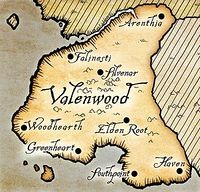
The Camoran Dynasty, also known as the Camorian Empire, was an aristocratic dynasty that ruled Valenwood for much of its history. One of the earliest known dynasties in Tamriel, its founding by King Eplear is an event traditionally regarded as the beginning of Year Zero of the First Era. Eplear's success in uniting the inherently wild Bosmer has been argued to be one of the greatest military feats in Tamriel's history. The Camorans remained in power for centuries afterwards, even resisting the aggressive expansion of the Alessian Empire, until Valenwood was conquered by the Second Empire in 1E 2714 following years of unrelenting warfare and the devastation of the Thrassian Plague. The Camoran Dynasty survived, but the Empire broke its influence by granting independence to Valenwood's lesser nobles.
When the Second Empire fell in 2E 430, the Camorans unsuccessfully attempted to reestablish their reign, but Valenwood's territories had drifted too far apart culturally to be united and the region descended into conflict. Valenwood would briefly achieve unity under Camoran rule only twice during the Interregnum, and then only as a member of the first and second Aldmeri Dominions. At the time of the first Aldmeri Dominion in the Sixth Century of the Second Era, Aeradan Camoran was crowned king and joined the Dominion to defend his realm against encroaching Colovians in the north. Viewed by some Bosmer as disrespectful of the Green Pact, Aeradan was forced to fight a civil war against the Blacksap Rebellion led by his cousin Gelthior Camoran, and later suppressed an attempted second insurrection by Gelthior's sons Gorinir and Lorchon in 2E 582. A subsequent dispute over the succession between the Camoran heirs in 2E 830 led to the intervention of the Altmer and the crowning of Camoran Anaxemes, who pledged fealty to the king of Alinor and thereby ushered in the second Dominion. Anaxemes was then forced to cede much of his power to the Thalmor, a congress of Bosmeri chieftains and Altmeri diplomats who proved modestly effective until Tiber Septim swept them away. Gorinir family was a cadet branch of the Camoran royal line.
Under the Third Empire, the Camorans retained the throne of Valenwood as figurehead monarchs. The year 3E 249 saw another dispute arise over the Camoran succession, a dispute which soon escalated into a massive war that threatened the whole of the Empire. One claimant to the throne, Camoran Kaltos, conquered most of Valenwood in two years with the aid of Haymon Camoran, also called Haymon Hart-King, another claimant and Kaltos's chief advisor and sorcerer. Against Kaltos's wishes, however, Haymon declared war on the people of Colovia and marched his armies north. Kaltos pleaded with Haymon to return to Valenwood, but Haymon betrayed him and claimed the Camoran throne for himself, thus becoming the Camoran Usurper. The Usurper's armies ravaged western Tamriel for nearly twenty years, driving through Hammerfell all the way to High Rock while Kaltos unsuccessfully fought to stop him. At last the Principality of Dwynnen marshaled the other city-states of High Rock and joined forces with Camoran Kaltos to defeat the Camoran Usurper at the Battle of Firewaves; Haymon Hart-King was killed in the battle.
Kingdom of Orsinium[edit]
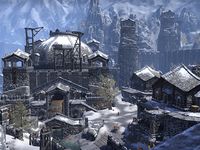
- Main article: Orsinium
Numerous incarnations of Orsinium have risen and fallen over the eras, but only three are known to history. The Kingdom of Orsinium was first built by King Torug in High Rock, straddling the boundary between western Wrothgar and Rivenspire. It was later bolstered by many goblin-ken migrations upon their emancipation from slavery, notably Thulgeg's migration in 1E 874,[67] before it was destroyed by Breton and Redguard forces during the Siege of Orsinium. In the mid-Second Era, the city was relocated to eastern Wrothgar under King Kurog. In 3E 399, it was relocated again to a site between Wayrest, Menevia, and the Wrothgarian Mountains, but among the chaos of the Stormcrown Interregnum was sacked between 4E 11 and 4E 15.[66] By 4E 201, Orsinium had moved once more, farther south to an area between Hammerfell and Skyrim.
Although Orsinium was accepted as a territory of the Second Empire during the reign of the Akaviri Potentate, it largely remained as an independent state.
See the main article for more information.
Yokudan Empire[edit]
The Yokudans had existed on Yokuda since the Merethic Era and during this time warred with the Lefthand Empire for a thousand years. The Yokudans eventually defeated the Lefthanded Elves and prospered in their own right, culminating in the establishment of their own empire.[68][10][69] The ruling body of the Yokudan people was known as the Na-Totambu, a council of kings who represented the various nations of Yokuda.[70][71]
By the First Era, Yokuda had become a vast empire, and developed a tradition of being ruled by a single emperor, however this was eventually abolished in 1E 376. Although each successive emperor remained as the figurehead of the empire, his powers were very much reduced. As a result, the nation descended into three hundred years of continuous civil war between the provincial lords, warrior monks, and brigands, all fighting each other for land and power.[68] In 1E 609, Mansel Sesnit became the Elden Yokeda, or military dictator and waged many of the battles of unification and succeeded in gaining control of almost the entire empire until he was assassinated in 1E 617. His successor, Randic Torn, took over and continued the work of Sesnit, however by the time of his death in 1E 737 internal disturbances still had not been completely eliminated. After his death, another vicious civil war broke out.[68]
In the chaotic aftermath, the "Last Emperor" of Yokuda, Hira, rose to power and attempted to wrestle control of the empire from the people by exterminating the sword-singers. This conflict became known as the War of the Singers. In 1E 780, it came to a climax at the foot of Hattu Mountain, where Frandar Hunding's army of singers crushed the emperor's forces.[72][68]
While the Yokudan Empire in its original form fell in earnest after Yokuda sank into the ocean around 1E 792, the Na-Totambu ruling class who migrated to Hammerfell attempted to reproduce the culture and rule of Yokuda as close as possible, with mixed results. This meant that while the empire itself was gone, the Yokudans (and later the Redguards) continued the tradition of monarchic rule in some capacity.[73] One notable example was a Yokudan noble named Tarish-Zi who proclaimed himself emperor and led his warrior band to Craglorn in order to establish his own empire. While he ruled in the ancient Yokudan way, eventually his empire faded into obscurity in the years that followed.[74] Another example was a Yokudan noble named Prince Hubalajad who colonized Hew's Bane and established Abah's Landing, from where his descendants would rule for several generations before fading away.[75][76] Another example of parts of Hammerfell being ruled under a monarchy was the rise of Queen Afsar of Alik'r. According to legend, the ruling king died in the late First Era with no heir, which led to squabbling between the Na-Totambu over succession to the throne. Afsar was said to have seized the throne the ancient way by killing the opposition and solidifying her rule. Despite its bloody start, her reign was supposedly very peaceful.[77]
The last known monarch of Hammerfell during the First Era was High King Ar-Azal of the Phyllocid Dynasty, who was best remembered for healing the rift between the Na-Totambu ruling class and the warriors of the Ra Gada by marrying the daughters of their greatest Grandees.[78] When Hammerfell fell to Reman I and was absorbed into the Second Empire, the role of High King was seemingly abolished. Instead, the Na-Totambu and Ra Gada (now known as Crowns and the Forebears respectively) would go on to aid Cyrodiil's administration of Hammerfell. The Crowns retained the rights of noble council and the Forebears were granted rights of ownership within their tribal districts.[79] This however didn't last, and the Kingdom of Hammerfell that emerged during the Interregnum almost seven hundred years later could be considered the successor to the Yokudan Empire, given the Na-Totambu ruling class took power and reverted back to a hereditary monarchy.[80]
First Empire of the Nords[edit]
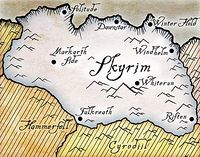
The First Empire of the Nords, also known as the Nord Empire, is the collective term for the Nordic kingdom during a phase of expansion in the First Era, known as the Skyrim Conquests. Its capital was the city of Windhelm in Skyrim, where a First Empire palace still stands. The empire was formed when King Vrage the Gifted began a campaign to conquer High Rock and Morrowind (a feat that is attributed by some to Sai, the God of Luck) circa 1E 240. By the end of the conquests, the First Empire of the Nords encompassed Skyrim, parts or all of High Rock (sources conflict), Morrowind with the exception of the Dwemer kingdom of Vvardenfell, and a large portion of Cyrodiil's Nibenay Valley. These invasions upset the balance in High Rock and Cyrodiil, and although the Nords' empire lasted less than two centuries, the result was decisive; from then on, power in those regions shifted from the elves to the humans.
Though the last ruler, King Borgas, died in 1E 369, the ultimate end of the First Nordic Empire came in 1E 420, when the Pact of Chieftains ended the War of Succession and the empire finally shattered; Skyrim eventually lost all of its holdings in Morrowind, Cyrodiil, and High Rock, and many of the Nordic kingdoms began to declare independence. The Nords were driven from Morrowind by force when Indoril Nerevar and Dumac Dwarfking joined together, repelling the invaders in 1E 416.
Alessian Empire[edit]
The Alessian Empire, also called the First Empire, the Empire of Cyrodiil, and the Empire of Men, was established by the former Nede slaves of the Ayleid Empire in 1E 243 following the Alessian Slave Rebellion. The Empire traces its founding to the moment when Saint Alessia received the Dragonfires and the Amulet of Kings from Akatosh; she used the Amulet to drive the Daedra out of the mortal realm. Akatosh told Alessia that as long as the Dragonfires remained lit and her heirs wore the Amulet of Kings, the gates of Oblivion would remain shut and Tamriel would be spared the depredations of the Daedra.
Only a few rulers of the First Empire are now known: Queen Alessia, its founder and spiritual leader; Belharza the Man-Bull, Alessia's heir by her consort Morihaus, crowned in 1E 266; Gorieus, crowned in 1E 461; and Hestra, who expanded the reaches of the Empire all the way to High Rock in 1E 1029. One of the defining events of the Empire was the rise of the zealously monotheistic Alessian Order, which followed the teachings of the prophet Marukh. The Order's influence spread rapidly until, in 1E 361, its puritanical doctrines were formally adopted and enforced by the Empire. Thereafter, the arch-prelates of the Order were said to wield almost as much power as the emperors themselves. It was a sect of the Order called the Marukhati Selective that was responsible for the Dragon Break known as the "Middle Dawn".
The Alessian Empire's territory fluctuated considerably throughout its history. At its inception it encompassed East Cyrodiil, including the Nibenay Valley and the White-Gold Tower, which later became the centerpiece of the Imperial City; West Cyrodiil remained a patchwork of independent Colovian kingdoms that resisted the Alessian Order's dogma. A number of Ayleid vassal-states also briefly existed under the Empire's umbrella until the xenophobic Alessian Order methodically extinguished them. Following the defeat and death of High King Kjoric the White in 1E 478, the Empire seized portions of southern Skyrim, but failed in its bid to acquire the Kingdom of Skingrad. A westward expansion and attempt to annex High Rock was likewise thwarted at the Battle of Glenumbra Moors in 1E 482, which would be remembered as one of the Order's most disastrous mistakes. High Rock would later be inducted into the Empire in 1E 1029 after the Empress Hestra defeated King Styriche, the Vampire of Verkarth, only to reassert its independence in 1E 2305 in response to the Alessian Order's excesses. In 1E 1033 the Alessians under Hestra invaded Black Marsh to suppress the pirates led by Red Bramman operating from the Topal Bay. An unknown Alessian Emperor agreed to fund the All Flags Navy's campaign against the Sload of Thras in 1E 2241. Under the command of King Bendu Olo, the fleet sailed to Thras in 1E 2260 to mete vengeance upon the Sload for releasing the Thrassian Plague on the people of Tamriel.
The final days of the Empire arrived in 1E 2321, when tensions within the Alessian Order's bloated priesthood gave way to internal strife, prompting the kingdoms of West Cyrodiil to completely sever ties with the Empire and establish their own government, the Colovian Estates. Hemorrhaging money and land, the Empire finally broke under the strain and the War of Righteousness erupted. After a decade of violence that wiped out half of the population of the Iliac Bay and saw the loss of the Order's extensive monastic complex at Lake Canulus, among untold other atrocities, the war ended in 1E 2331 with the dissolution of the Alessian Empire and Order both. Cyrodiil and Tamriel would remain divided until the rise of Reman I and the foundation of the Second Empire in 1E 2703.
Direnni Hegemony[edit]
The Direnni Hegemony was an ancient Elven power that rose to dominance in High Rock around 1E 355. However, some consider their rule in the years leading up to its establishment as part of the Direnni Hegemony as well. By the middle of the First Era the whole of High Rock was commonly called the Direnni Hegemony before collapsing almost completely in 1E 498. As an economic and military power, they were notable for their victories over the battle-hardened Nordic Empire of Skyrim and the nascent Alessian Empire of Cyrodiil. The Direnni clan had migrated to High Rock during the Aldmeri diaspora of the Middle Merethic Era, alongside several other families. The progenitor of Clan Direnni was Direnni Cygnus, who was said to have discovered the Isle of Balfiera and the Adamantine Tower and claimed them for her own clan. Some believe the Direnni left the Summerset Isles as they were following their destiny to rule from Balfiera, while others believed that they were exiled.
During the Merethic Era the Direnni came into contact with a Nedic peoples, known today as the Druids of Galen (or proto-Bretons). Whether these Nedes were native to High Rock or migrated is still debated in scholarly circles, but regardless Clan Direnni exerted its influence upon them and established the feudal system whereby they ruled the Nedes as a noble caste.
Rise to Power[edit]
By the early First Era the Direnni had become an economic and military power but had to contend with the rampaging Nordic armies of Vrage and his Skyrim Conquests in 1E 222, which saw much of High Rock being annexed under the First Empire of the Nords. Indeed, Vrage's pretext for war was that he believed the enslaved Bretons were descendants of captured Nords from the Night of Tears. The Direnni and the other Aldmer clans kept hold of their lands and were aided in battle by many of their Breton vassals, while Nords founded fortified towns, such as Daggerfall, along the coasts to support their pillaging parties.
It is speculated that there was internal strife between the various Aldmer clans of High Rock. A century later despite the infighting between the various clans over who would rule, the Direnni prospered and rose to dominance through political manoeuvring and various machinations around 1E 355, establishing the Direnni Hegemony in earnest. It was during this time the First Empire of the Nords was approaching its final years, and in one of its last campaigns attacked the Western Reach with the aid of Emperor Ami-El of Cyrodiil in 1E 358. The campaign failed and Skyrim lost more and more of Greater Bretony to the Direnni. With the rise of the Alessian Order in Cyrodiil in 1E 361, many fleeing Ayleids migrated to High Rock to escape persecution in an exodus known as the Ayleid Diaspora. Most notabally Laloriaran Dynar, who was welcomed by the Direnni and given lands to settle in 1E 375. Scholars speculate that the rise of the Direnni Hegemony may be linked to influx of Ayleids into High Rock.
Only fourteen year after the Nord's failed invasion of the Western Reach, the War of Succession erupted in Skyrim in 1E 369, greatly weakening them. The Direnni Hegemony took full advantage of their internal strife and pushed out the Nords, ending almost 150 years of Nordic occupation. In 1E 461, Ryain Direnni purchased the Isle of Balfiera, strengthening the Direnni Hegemony's claim over the isle, and later warred with High King Kjoric the White of Skyrim. With the aid of Laloriaran Dynar, the Direnni emerged victorious and continued their military expansion.
By 1E 477, the Direnni Hegemony managed to conquer High Rock entirely, and even some parts of Skyrim and Hammerfell, going as far east as Markarth and Elinhir. The Direnni Hegemony had become formidable enough to pose a continued threat to its neighbors, and at the peak of their power controlled nearly a quarter of Tamriel.
The Fall[edit]
In 1E 478, the Alessian Empire under Emperor Gorieus was bearing down on its rebellious vassals and launched an attack on the Colovian Estates. After King Rislav Larich of Skingrad routed Gorieus' army, the Direnni were inspired to outlaw the religion of the Alessian Reform throughout High Rock, and began pushing into Imperial territories. Soon after, the Direnni Hegemony joined the resistance alongside High King Hoag Merkiller of Skyrim. Ryain Direnni outlawed the Alessian Reform and executed its missionaries. Direnni forces began to harass the Colovian West, pushing into the Heartlands. Following the Direnni involvement in Cyrodiil, the Alessians retaliated and began conquering territories of the Direnni Hegemony. By 1E 479 Craglorn had fallen to the Imperials.
Although the Aiden Direnni pushed back in 1E 480 and led a series of minor but important victories against the Alessians in High Rock, it was clear the Direnni were in need of more troops. Aiden Direnni signed the Rights Charter out of necessity, in efforts to muster troops for the coming conflict. Daggerfall became a minor base of operations for the Direnni and their allies.
The conflict with the Alessians came to a head at the Battle of Glenumbria Moors in 1E 482. Aiden's army defeated the Alessians on the 8th of Sun's Dawn with the assistance of Breton knights, the last Ayleid king and Hoag Merkiller. Although the Alessians were crushed at the Battle of Glenumbria Moors, the victory weakened Direnni power in High Rock. In the following years it became evident that the scattered and exhausted Direnni had overextended their reach. Year-after-year the Direnni could no longer challenge the emerging Breton nobility, who seized power throughout most of High Rock by 1E 498. Losings all the territory they had gained, the Direnni were forced to fall back to their original home on Balfiera. Increasingly vilified by their former vassals, the island clan became ever more insular and isolationist thereafter.
Kingdom of Resdayn[edit]
The Kingdom of Resdayn refers to the short-lived alliance between the Dwemer and Chimer in the early First Era. The Nords had initially occupied Morrowind during the Skyrim Conquests in 1E 240, but this eventually led to a rebellion led by Indoril Nerevar of the Chimer and Dumac of the Dwemer. An alliance was formed between them and the Nords were pushed out by 1E 416. This alliance born out of need formed the First Council.[56]
Nerevar and Dumac ruled jointly over Resdayn. The peace between the Dwemer and Chimer brought prosperity, but the War of the First Council broke out when relations went sour. It ended with the Battle of Red Mountain in 1E 700, which saw the death of both leaders. In the aftermath, the Chimer changed into the Dunmer, while the entire Dwemer race suddenly disappeared,[64] and the golden era of the Tribunate began.[81][82]
Kingdoms of High Rock[edit]
After the Alessian Empire was defeated at the Battle of Glenumbria Moors, Direnni power in High Rock began to wane. Year-after-year the Direnni could no longer challenge the emerging Breton nobility, who seized power throughout most of High Rock by 1E 498.[83][84][85] Clan Direnni's retreat to Balfiera left a vacancy in the way of a united government, and High Rock was left with a hundred fiefdoms to squabble over power.[84]
The rise of kingdoms initially started through villages founded in tactical locations, such as Wayrest, prospering and becoming fully fledged powers.[86]. Breton kingdoms grew around the eight major cities of Daggerfall, Camlorn, Wayrest, Shornhelm, Northpoint, Evermore, Farrun and Jehanna.[87] These kingdoms gave rise to many dynastic families and houses, such as the Cumberland Dynasty, Gardner Dynasty and Spenard Dynasty.
Reachmen Kingdoms[edit]
- "Anyone can be a king in the Reach. No one can be a king of the Reach." — Reachman proverb
Throughout history, Reachmen have lived in separate clans across the Reach. On occasion the clans have put aside their differences and banded together to form a loose kingdom, usually to unite against a common foe. The first recorded instance was around 1E 1030, when the Reach was ruled by ten warring Reachman kings. Most of the kings submitted to the invading Alessian forces of Empress Hestra, however a legendary Reachmen known as Red Eagle united the clans and led a rebellion. The King of the Reach pushed back against the invaders for two years and was hailed a hero, but the Alessians ultimately were successful and killed the rebel king.[88][89]
Following the Second Empire's collapse in 2E 430, the Reach was left to its own devices. It eventually became an independent kingdom ruled by the Reachmen themselves under the infamous Durcorach the Black Drake, who conquered the Empire of Cyrodiil and installed himself as the first of the Longhouse Emperors.[90] Durcorach met his demise during a failed invasion of High Rock in 2E 542.[91]
By 2E 578, even as Durcorach's grandson Leovic reigned over the Empire, control of the Reach had passed to the so-called Despot of Markarth.[92] Amidst the chaos of both the Planemeld and the Three Banners War, numerous Reachman tribes attempted to extend their influence into High Rock and Skyrim, but met fierce resistance.[93] Shortly before 2E 582, The Kingdom of Western Skyrim carved a new hold named Karthald from the northern territory of the Reach to use as a bulwark against Reachman incursions into Haafingar and Hjaalmarch.[94]
In 4E 174, nationalistic Reachmen passively resisted Nord rule for centuries until finding the perfect opportunity to strike. While the forces of the Empire were committed to fighting the Aldmeri Dominion in the Great War. The Reachmen rose up, seizing Markarth and most of the hold, ruling the Reach as an independent kingdom for two years under Madanach, the King in Rags. The government of Skyrim, growing desperate, enlisted a militia led by Ulfric Stormcloak which retook the Reach in 4E 176. The survivors of the revolt were scattered into the wilderness, becoming the Forsworn.[95]
Second Empire[edit]
- Main article: Second Empire
The Second Empire, also known as the Cyrodilic Empire, and the Second Empire of Men, was a human-led empire that, at its height, controlled every region of Tamriel with the exception of Morrowind. The history of the Second Empire is divided into two main periods: the reign of the Reman Dynasty that witnessed the final centuries of the First Era, and the subsequent Akaviri Potentate, sometimes stylized as the Akaviri Empire, that ushered in the Second Era.
See the main article for more information.
Elsweyr Confederacy[edit]
The Elsweyr Confederacy was formed when the warring Khajiiti kingdoms of Anequina and Pellitine merged in 2E 309. Aware of the political impact, Keirgo of Anequina and Eshita of Pellitine married and combined the two kingdoms into the nation of Elsweyr. The formation of the new kingdom did not bring the expected peace. The cleft between tribal culture of the north and nobility of the south was still present. The power between the two former kingdoms, each with their own central government and allied tribes, shifted to the nobility. The chieftains of the north felt betrayed by both their ruling classes and forgot about their vendettas only to sign treaties of their own. Soon the cities of former Anequina were under constant attack, leaving King Keirgo no choice than to petition to the Second Empire for aid. The Empire itself was in similar unrest after their own ruler, Potentate Versidue-Shaie, was assassinated in his palace in Senchal in 2E 324. As Ne Quin-al, the old capital, fell to the rebels, the young confederation seemed ready break apart.
As the rebellion continued, Mane Rid-Thar-ri'Datta, the nonpartisan spiritual leader of the Khajiit, revealed the Riddle'Thar Epiphany in the Temple of Two-Moons Dance of Rawl'kha in 2E 311. The Mane used Riddle'Thar to proclaim a new system of dividing the powers in Elsweyr. Bound to the dance of the two moons—their different phases—the power in a region shifted between the nobility of the cities and the chieftains of the deserts. The Mane itself was overseeing this shift of powers, and as this system was implemented it finally brought peace to Elsweyr some time around or after 2E 324—lasting under many more Manes. The edicts from this key event in Khajiiti theology however were not accepted by everyone at this time, leading to those exiled and their temples deconsecrated.
Two hundred years later during the chaos of the Interregnum, the Knahaten Flu ravaged the land of the Khajiit. As the Khajiit were focused on fighting against their own extinction, they saw aggression from the Camoran Dynasty and Colovia. Colovian armies, during the reign of the Longhouse Emperors, invaded the northern Elsweyr and annexed it. Their invasion went as far as Riverhold and Orcrest, until they were pushed out around 2E 562. This didn't stop the Colovians, and in 2E 576 Euraxia Tharn became Queen of Rimmen after staging the Frostfall Coup. The occupation was short-lived after Euraxia was killed and Rimmen was brought back under the control of the Khajiit in 2E 582, although the Elsweyr Confederacy was left in shambles.
Knahaten Flu continued to spread across Elsweyr until aid came unexpectedly from the Queen Ayrenn and the Kingdom of Alinor, bringing direly needed physicians, healers, and supplies. This aid gradually defeated the Knahaten Flu and saved the Khajiit. In return for, Queen Ayrenn asked the Khajiit to stand by her side as invading armies moved towards south-west Tamriel, to which the Elsweyr Confederacy agreed. The signing of the Elden Accord by Queen Ayrenn, Lord Gharesh-ri and King Aeradan Camoran formed the First Aldmeri Dominion in 2E 580. Under the united banner of the Dominion, they entered the Three Banners War The Elsweyr Confederacy contended with numerous other threats during the Three Banners War. Colovians once again invaded northern Elsweyr under Javad Tharn and worked together with the Stonefire Cult to corrupt the current Mane Akkhuz-ri and anoint his own Dark Mane, thus corrupting the spiritual soul of the Khajiit. The conflict came to a head in the city of Dune, where Javed launched an attack by opening Daedric portals and allowing Daedra into the streets. The Khajiit fought back and his plan failed, ending the Daedric threat.
In an effort to stop the Three Banners War, Abnur Tharn inadvertently unleashed the Dragons Kaalgrontiid, Laatvulon and their minions from their containment from the Halls of Colossus. Kaalgrontiid continued pursuing the Prophecy of the New Moon that would see him become the Dark Aeon and ascending to godhood. A Khajiiti dragon cult, known as the New Moon Cult appeared around this time to aid Kaalgrontiid's schemes. Queen Khamira and the recently reformed Dragonguard forged an alliance with the red dragon Nahfahlaar. Through their combined effort, the eventually went on to defeat Laatvulon and later Kaalgrontiid.
Although Rimmen briefly seceded from the Elswey Confederacy in 2E 812, the ascending Tiber Septim began conquering parts of Anequina during the Tiber War. In the Halls of Colossus, Tiber Septim reconstructed and reactivated the Numidium. Not long after, Senchal was besieged by Imperial troops under General Pottreid. The population did not surrender and was slain entirely. Ultimately, Elsweyr was annexed to become a province of Tiber Septim's Third Empire.
While Elsweyr thrived under the Empire for most of the Third Era, in 4E 10 the Stormcrown Interregnum began - only ten years after the Oblivion Crisis. Elsweyr once again found itself independent of the Empire, but was granted no peace. In or around 4E 48 the Mane was assassinated, sinking the south of Elsweyr into chaos. During this time, an unknown figure proclaimed himself Potentate of Rimmen and surrounding areas. In 4E 98, Masser and Secunda vanished from the sky for two entire years. The so-called Void Nights ended in 4E 100 with the return of the moons, while the Thalmor took credit for bringing them back. Whether or not they were actually responsible for this turnaround remains unresolved. Nevertheless, as the Khajiit people and culture are tied inexorably close to the moons, the Thalmor were able to win great influence over them as their apparent saviors. Within the following fifteen years, until 4E 115, the influence of the Empire dwindled so much it was unable to stop the coup which dissolved the Elsweyr Confederacy and recreated the original kingdoms of Anequina and Pellitine as client states of the Third Aldmeri Dominion.
Empire of Cyrodiil[edit]
- Main article: Empire of Cyrodiil
The Empire of Cyrodiil (also known as the Imperial Empire) refers the remnants of Second Empire that existed during the Interregnum. Although identified as an empire, it differed from the Alessian Empire, Second Empire, and Third Empire in that its only permanent dependency was Cyrodiil itself, and it was at no time ruled by a Dragonborn emperor. While there were periods of relative stability, such as under the Longhouse Emperors, the Ruby Throne saw many pretender-kings. Of note was the Three Banners War where armies of the Dominion, Covenant, and Pact invaded Cyrodiil in an effort to topple the throne and take power.
See the main article for more information.
Longhouse Dynasty[edit]
The Longhouse Emperors were a dynasty of Reachmen who seized the Ruby Throne and ruled the Empire of Cyrodiil for a period of forty-four years during the Interregnum. Regarded as eccentric at best and utterly alien at worst by Cyrodiil's populace, the Longhouse Emperors' reign began when Durcorach the Black Drake and his warriors conquered Cyrodiil in 2E 533, a feat believed to have been made possible with the aid of sympathetic Imperial nobles and secret Daedra worshipers who struck a deal with Mehrunes Dagon. In an effort to solidify his tenuous claim to the throne, Durcorach married Veraxia Tharn of the prominent Tharn family of Nibenay in 2E 534, and also appointed a new Elder Council. Durcorach eventually met his end while leading an army of Reachmen in an invasion of High Rock in 2E 541; after raiding several cities, Durcorach's army was broken outside Daggerfall, and the Longhouse Emperor himself was slain by Emeric of Cumberland.
Moricar the Middling, Durcorach's son, succeeded him at the age of 23. Moricar had been born and raised in the Reach like his father, but had spent his teenage years under Imperial tutelage and was said to better understand Cyrodilic culture. In 2E 563, Moricar launched an invasion of Western Skyrim. Accounts of the campaign differ. In one, Moricar remained in the Imperial City rather than lead the army as his father would have. This decision likely spared his life, as his forces were humiliatingly routed in a single battle by the army of High King Svargrim, but he was consequently lambasted as a coward by Western Skyrim's bards. In another account, Moricar led his troops to the gates of Solitude before Svargrim's army attacked in overwhelming numbers. Moricar was gravely wounded in the battle and returned to Cyrodiil, where Imperial and Reach healers were only able to keep him alive until the following year.
In 2E 564, Durcorach's grandson Leovic inherited the Ruby Throne. Following suit with his grandfather by marrying a Tharn, Clivia, Leovic's reign was initially only marked by the emperor's peculiar behaviors, which the Cyrodilic nobility blamed on his Reachman upbringing. Eventually, however, Leovic crossed the line when he legalized Daedra worship, allegedly at the behest of corrupt advisors, and consequently drew the ire of many nobles who had once been counted among his supporters. One of these erstwhile supporters, Duke Varen Aquilarios of Chorrol, marshaled the armies of the Colovian Estates and led them against Leovic in open rebellion from 2E 576 to 2E 577. In the end, Leovic was killed by Varen in the Imperial Throne Room, and the era of the Longhouse Emperors came to a close. Durcorach's line was survived by his kin in the Reach, the Blackdrake Clan, and after Leovic's demise, the clan's chieftainship was claimed by Caddach, a cousin who had been installed as the Imperial Governor of Markarth by Moricar.
Kingdom of Hammerfell[edit]
The Kingdom of Hammerfell that emerged during the Interregnum can be considered the successor to the Yokudan Empire, given the Na-Totambu ruling class took power and reverted Hammerfell back to a hereditary monarchy. Before being absorbed into the Second Empire, Hammerfell was ruled by the Phyllocid Dynasty under High King Ar-Azal of Hegathe. King Ar-Azal was best remembered for healing the rift between the Na-Totambu ruling class and the warriors of the Ra Gada by marrying the daughters of their greatest Grandees.
Under the provincial organization of the Second Empire, the role of High King was seemingly abolished as Ar-Azal became known the last king of his dynasty. Instead, the Na-Totambu and Ra Gada (now known as Crowns and the Forebears respectively) would go on to aid Cyrodiil's administration of Hammerfell. The Crowns retained the rights of noble council and the Forebears were granted rights of ownership within their tribal districts. While there was no ruling monarchy, other titles and roles were known to exist at this time. High-ranking Crown nobles were called Magnifico and Magnifica, depending on gender. Similarly, Grandee and Grandeyas were titles associated with various roles, including provincial governance, leading armed forces or members of the court.
Interregnum[edit]
After the fall of the Second Empire in 2E 430, control of Hammerfell reverted back to the hereditary monarchy of the Na-Totambu, giving birth to the various kingdoms of Hammerfell. The new High King, in a bold move, shifted the capital from Hegathe to the more prosperous Forebear city of Sentinel, which had, by this time, mastered a third of the trade of the Iliac Bay.
In the mid-Second Era, King Ramzi the Distrait ruled the Kingdom of Sentinel, but was self-serving and weak-willed and failed to protect his subjects from the Knahaten Flu. As death spread to his courtiers, Ramzi sealed himself within Samuruik palace and slowly starved to death, leaving the kingdom in despair. A young Forebear noble named Fahara'jad, descendant of Ar-Azal, traveled from Bergama and declared himself king of Hammerfell. Support for the new king wasn't unanimous and Hammerfell wasn't unified under Fahara'jad. The Crown nobility in the southern cities of Hegathe, Gilane, Taneth and Rihad supported Grandee Zizzeen's claim to throne instead. The Crowns suspected King Ramzi was usurped and acted with vehement repudiation against Fahara'jad, however Forebear viziers and northern chieftains ratified his accession.
Around this time, the Forebears were progressives who firmly support the Daggerfall Covenant while the traditionalists Crowns rejected the practices of Tamriel and clung to their old ways. Possibly sensing an uprising from the south, Fahara'jad allied himself with the Daggerfall Covenant to strengthen his position and pronounced himself High King of all Hammerfell, and even arranged the marriage of his daughter to High King Emeric of High Rock. This action further infuriated the Crown nobility in the south, such as the royal family of Hegathe, as they openly opposed Fahara'jad's accession. Despite being unable to challenge his claims, they secretly plotted against and spied on Fahara'jad's kingdom. While Fahara'jad ruled Sentinel, the Alik'r and beyond, its unknown if Hammerfell's other kingdoms, such as the Kingdom of Taneth, recognised him as High King.
The Tiber War[edit]
The line of High Kings that ruled from Sentinel continued with Thassad II, but the city had switched to the rule of the Crowns. As the conquests of Tiber Septim began to expand and enroach on his domain, Thassad II resisted all forms of Imperial invasion. When the High King passed away in 2E 862 the capital was retaken by the Forebears under the command of Baron Volag, ensuing a vicious civil war between the Crowns and Forebears. When the latter enlisted the help of the Third Empire, the Forebears gained the advantage and resulting in the Crowns losing their territories until Stros M'Kai was left. The Battle of Stros M'Kai was won and the Empire swiftly took control over all of Hammerfell, imposing several provisional governors to rule its regions. Both factions reconciled a year later after an uprising against the Empire, which forced Tiber Septim to sign a more favorable treaty that formally established the Imperial Province of Hammerfell. Sentinel, however, remained as its provincial capital. It is unknown when the next High King ascended to the throne after Hammerfell was absorbed into the Empire, but the rift in Hammerfell society was not mended.
Third and Fourth Eras[edit]
During the Imperial Simulacrum the War of the Bend'r-mahk erupted in 3E 396. Skyrim defeated the forces of Hammerfell and High Rock and claimed many miles of the eastern parts of those provinces, including the cities of Elinhir and Jehanna. Some of these territories were claimed to have been lost in previous wars at the expense of Skyrim. By 3E 403 King Camaron of Sentinel was in power during the province's short but vicious land dispute with Daggerfall over the island of Betony. Following the Miracle of Peace in 3E 417, Sentinel under King Lhotun greatly expanded to take over the entire northern coast of Hammerfell.
Centuries later, the Thalmor of the Aldmeri Dominion would attempt to seize control of Hammerfell from the Third Empire. Emperor Titus Mede II's refusal to concede to Thalmor demands triggered the Great War in 4E 171. Aldmeri forces crossed western Cyrodiil and invaded Hammerfell's southern coast, easily sweeping through the scattered resistance put up by the disunited Redguards. Initially only seeking to conquer Hammerfell, the Dominion launched a full-scale invasion of Cyrodiil when it realized the Empire was weaker than previously believed. Imperial fortunes took a turn for the better in Hammerfell two years later, when a Forebear army from Sentinel broke the siege of the Crown city of Hegathe, leading to the reconciliation of the two factions. After the Empire's hard-won victory in the Battle of the Red Ring in 4E 175, the Empire and Dominion signed the White-Gold Concordat and ended the war. Outraged that the terms of the treaty called for a large portion of southern Hammerfell to be turned over to the Dominion, however, the Redguards soundly rejected it. Titus II was forced to officially renounce Hammerfell as an Imperial province to preserve the peace, and fighting between the Aldmeri and Redguards continued. In 4E 180, the Dominion agreed to the Second Treaty of Stros M'Kai and finally withdrew from the region, leaving Hammerfell an independent albeit devastated nation.
Kingdoms of Skyrim[edit]
After the disastrous War of Succession, the First Empire of the Nords crumbled as it lost control of its territories in High Rock, Morrowind, and Cyrodiil. While Skyrim as a nation remained relatively intact, its people were historically divided into Holds, ruled by a patchwork of clan-heads, kings, and councils. Among the Old Holds, the people still revered their hereditary leaders, while the other Holds governed themselves by elected moots.[12]
In the aftermath of the war in 1E 420, it became evident the former system of succession, known as the Moot, had become partisan and ineffective. When King Olaf died without a clear heir a new method of electing a High King became necessary.[12] This new method involved the creation of the Crown of Verity - a magical artifact used to test the worthiness of potential rulers of Skyrim. Throughout the remainder First Era, the Crown of Verity was been passed down from High King to High King, used as a tool by the Moot to ascertain the worthiness of any candidate for the throne.[96]
While the new system of succession was purported to be an overwhelming success in later eras (to the degree that Skyrim's leadership was supposedly never disputed on the field of battle in the following 3,000 years), this was not entirely true.[12][96] For brief periods, a single ruler managed to unite all of Skyrim, but the Nord character is one essentially of conflict, and the confederacies never lasted.[55] For example, in the late-First Era High King Irthvyd of Solitude died without an heir. His senior advisor, Temylda ascended the throne after duelling several jarls in single combat. Forty years later, Temylda's reign ended and a new leader was chosen out of bloodshed and violence. The warrior Alldimar, known for his many skirmishes with the Reachmen, wrestled the title from an untested child heir using his years of knowledge in arcane magic and his great sense of warfare.[97]
When the Second Empire was established in 1E 2704, Skyrim was either conquered or allied with Reman I relatively quickly as troops from Solitude were frequently sent into the Reach to pacify rebellious Reachmen.[92]}} Despite now being part of the Second Empire, Skyrim's retained their ancient system of leadership with Jarls, High Kings, and succession using the Crown of Verity.[96]
After the Second Empire fell, High King Logrolf was assassinated 2E 431 heralding a major change in Skyrim. Naturally, the throne would have been passed to the High King's heir, Jarl Freydis of Windhelm. However, tension had arisen between the east and west when Jarl Svartr of Solitude had challenged her claim to leadership and thus called for a moot. Freydis was accepted by the Crown of Verity and named High Queen, though part of the Moot chose Svartr as High King. What followed was a decisive schism that split Skyrim in two, creating distinct Western and Eastern Kingdoms.[98][99]
Kingdom of Eastern Skyrim briefly became part of a greater alliance called the Ebonheart Pact during the mid-Second Era. During the Second Akaviri Invasion in 2E 572, the city of Windhelm was sacked and Queen Mabjaarn and her heir Nurnhilde were slain, leaving the crown to Mabjaarn's son, Jorunn.[100] In an unprecedented show of cooperation between races with a great deal of historical enmity, the Nords, Dunmer and Argonians fought together to encircle the Akaviri forces in Stonefalls and drove the invaders back into the sea. This allegiance forged in battle was ratified with treaties, and thus the Ebonheart Pact was born.[101]
Eastern Skyrim fought in the Three Banners War as a member of the Ebonheart Pact, while Western Skyrim remained neutral.[102] At that time, The Reach did not belong to either kingdom and the Reachmen had banded together under the Despot of Markarth, who allied himself with Mannimarco.[103]
The two kingdoms of Skyrim, as well as The Reach, were eventually reunified into a single realm following the Tiber War.[104][105]. In the last days of the Interregnum, a petty king of the Colovian Estates, Cuhlecain, came to power alongside the leader of his legions, General Talos. A year later more than half of the Cyrodilic Empire was reclaimed or consolidated, and Cuhlecain captured the Imperial City and proclaim himself Emperor. Skyrim and High Rock, which bitterly opposed a return to Cyrodilic rule, gathered their armies for a joint invasion of the Colovian West. Talos met them on the field of Sancre Tor. The Nords that had come to oppose the Empire soon joined the General's forces, for when they heard his Thu'um they believed him to be a son of Skyrim and the heir to the Empires of Men. Cuhlecain was soon assassinated soon after and Tiber Septim rose to power, eventually conquering all of Tamriel.[12]
As with the Second Empire, Skyrim retained many its ancient customs of leadership as a province under Tiber Septim, and was considered the Empire's "strong arm".[106][55] Traditionally each Hold was ruled by a Jarl who in turn were ruled by the High King, but ultimately the High King swore fealty to the Emperor. Solitude became the city most directly influenced by Imperial culture and politics, thus it became the capital city and its Jarl served as the Imperial-sanctioned High King for centuries thereafter.[106][107] Indeed, many of Solitude's Jarls were connected to the Septim bloodline, such as Potema, the "Wolf Queen of Solitude".[108] As such, the Moot (and by extension the Crown of Verity) became formality and theater as opposed to official succession, leading some to view Skyrim's ruler as a puppet.
At times, some hold capitals were sometimes referred to as kingdoms in their own right, and their Jarls referred to as kings or queens, particularly by outsiders.[109][110] For example, the city of Solitude was oft referred to as the Kingdom of Solitude during the Third Era, or Queen Macalla of Dawnstar, who married King Thian of Solitude.[55]
In 4E 10 the Stormcrown Interregnum began, resulting much unrest. After seven long, bloody years the Stormcrown Interregnum was ended when a Colovian warlord by the name of Titus Mede seized the crown in 4E 168. He proved a shrewd and capable leader, such that Skyrim endorsed him as Emperor. Although the Empire was greatly weakened, Skyrim was one of the few provinces that remained prosperous and peaceful.[111][112]
That changed during the Great War, when Reachmen briefly seized Markarth and most of the Reach in 4E 174 in an uprising, however a militia led by Ulfric Stormcloak retook the hold two years later.[95] However this would pale in comparison to the Stormcloak Rebellion in 4E 201 - an event that drastically shifted in the political landscape and plunged Skyrim into another civil war. Jarl Ulfric Stormcloak, seeking independence from Imperial rule, killed High King Torygg resulting in the province being split two. One side vying for independence and a return to the old ways, and the other seeking to remain under the rule of the Empire.[113]
Third Empire[edit]
- Main article: Third Empire
The Third Empire (also called the Septim Empire) was declared by Tiber Septim in 2E 854 after the chaos of the Interregnum, and was forged through a decades-long conflict to unite Tamriel known as the Tiber War. It lasted throughout the whole of the Third Era and two centuries into the Fourth Era, when it began to decline. By this time it was comprised of two dynasties, the Septim Dynasty and the Mede Dynasty. It was also ruled briefly under a Potentate during the Stormcrown Interregnum.
See the main article for more information.
Kingdom of Black Marsh[edit]
Almost nothing is known about the Argonian kingdom in Black Marsh, also known as the Kingdom of Argonia.[114]. Almost all mentions of the king (dating as far back as the mid-Second Era) involve the Shadowscales, who were said to be ancient protectors of the royal family, the Argonain Royal Court and the king's personal assassins.[115][116][117][118] Conversely, some believe this is simple misinterpreted information, and that no such king has ruled since the pre-Duskfall days when Argonian civilization was at its height. The so-called "Scalded Throne" has supposedly been empty for centuries (if it existed at all), and the monarch's role as commander of the Shadowscales is said to be overstated.[UOL 4] In the pre-Duskfall era, the priests of Sithis (also known as Nisswo or Nothing-Talkers) ruled as kings and would often make sacrifices to Sithis.[119]
Whatever the existence of an Argonian monarchy may be, by the time of the Oblivion Crisis a political group known as the An-Xileel formed and were instrumental in defending Black Marsh from Mehrunes Dagon's invasion. The kingdom later seceded from the Empire after the Thalmor incited the Argonians to mount a massive uprising against southern Morrowind.[111] The exact structure of the An-Xileel is unknown, but they were known to have had an Archwarden by the name of Qajalil in 4E 48,[120]:30 and were led by The Organism, the ruling council based in Lilmoth.[120]:37
Coral Kingdoms of Thras[edit]
Coral Kingdoms of Thras are a group of small kingdoms located on the Thrassian Archipelago, surrounded by the Sea of Pearls.[121] It was the source of the deadly Thrassian Plague that swept Tamriel in 1E 2200.[122] Home to the amphibious Sload, the extent of territory the Coral Kingdoms controls is unknown. Over the centuries maps charted by spies reveal the number and size of islands has varied, suggesting they have a volatile kingdom which fluctuates its land mass.[2] Some kingdoms, such as Ul'vor Kus, are located undersea and are ruled by the mysterious Sea Sload.[121]
While the Sload organize themselves into kingdoms, their Sea Sloads brethren form small cabals of like-minded individuals who cooperate to attain some specific goal, such as the Abyssal Cabal in 2E 582. These cabals break up, reform, and reorganize as interests and necessity warrant.[121] The leadership of these Thrassian kingdoms is largely unknown, despite the various conflicts over the years. The only insight Tamrielic nations have into Thrassian cultural leadership is found in a damaged journal of a diplomat to Thras written prior to 1E 2260. In it the diplomat describes a curious ritual they witnessed after gaining an audience in the submerged tower of an "Elder Distended One". This being is further described having an "impressively corpulent body and strangely pulsating head" that then disgorged an unknown material from three eyes that emerged from its belly, which was consumed eagerly by attendants.
Some scholars speculate the Sload may have been original inhabitants of the Summerset Isles, which possibly explains their aggressive disposition towards Alinor. Though they never succeeded in reclaiming Summerset they have visited numerous horrors upon other nations, such as the Sack of Skywatch, the War of the Uvichil and the infamous Thrassian Plague.[122][2] The latter was severely punished by the All-Flags Navy when they sank the coral kingdoms into the sea in 1E 2260, however by 2E 864 there were reports that Thras had risen again and that the Sload were seen in various parts of Tamriel.[123]
Tiger-Dragon's Empire[edit]
Ka Po' Tun (meaning Tiger-Dragon's Empire), originally called Po Tun, is a nation of Akavir. It is inhabited by a race of cat-folk also called the Ka Po' Tun. They are ruled by Tosh Raka, the divine Tiger-Dragon who bears similarities to Akatosh. Ka Po' Tun has become a very great empire, stronger than Tsaesci in all but naval battle. When the Tsaesci attempted to enslave the dragons, the black dragons fled to Po' Tun. A great war was waged, which left both the cat-folk and the snakes weak, and resulted in the death of the dragons. Since that time, the cat-folk have tried to become the dragons. Tosh Raka was the first to succeed, and renamed the nation to Ka Po' Tun. Ka Po' Tun plans to kill the Tsaesci and then invade Tamriel.
Notes[edit]
- ^ According to Kodlak Whitemane, the Companions are "nearly 5000 years old", which would indicate that the Return occurred sometime in the last five centuries of the Merethic Era. Similarly, the memorial plaque for High King Harald in Windhelm proclaims him as 13th in the line of Ysgramor, which if referring to generations, would indicate Ysgramor being alive around the second century before the end of the Merethic Era.
- ^ King Gellir could not have reigned any earlier than 1E 533. His chief accomplishment is the conquest of Skyrim's Dwemer city-states, and according to Arkngthamz-Phng, those city-states were not established until the decades after Clan Rourken founded Volenfell in 1E 420. Since the consecutive reigns of four other High Kings span the years between 1E 420 and 1E 533, Gellir could only have ruled sometime after 1E 533. The Aetherium Wars notes that the Dwemer reclaimed their lands "a century" after Gellir's conquests, and since the Dwemer had disappeared by 1E 700, it is likely that Gellir's reign occurred before the end of the 6th Century of the First Era.
References[edit]
- ^ a b c The False Revanchism of the Maormer — Hadendril of Skywatch
- ^ a b c d e f Pocket Guide to the Empire, 3rd Edition: Other Lands — Imperial Geographical Society, 3E 432
- ^ The Wolf Queen, v4 — Waughin Jarth
- ^ The Chosen People of Aldmeris — Sealord Malleroth Of Pyandonea
- ^ Crafting Motif 64: Pyandonean Style — Telenger the Artificer
- ^ a b Pocket Guide to the Empire, 3rd Edition: The Blessed Isle: Alinor and the Summersets — Imperial Geographical Society, 3E 432
- ^ Pocket Guide to the Empire, 3rd Edition: The Wilds Remain: Valenwood — Imperial Geographical Society, 3E 432
- ^ Treaty of Khenarthi's Roost
- ^ a b c Gelebor's dialogue in Skyrim
- ^ a b Varieties of Faith... — Brother Mikhael Karkuxor of the Imperial College
- ^ a b Night of Tears — Dranor Seleth
- ^ a b c d e f Pocket Guide to the Empire, 1st Edition: Skyrim — Imperial Geographical Society, 2E 864
- ^ Fall of the Snow Prince — Lokheim
- ^ Skorm Snow-Strider's Journal — Skorm Snow-Strider
- ^ Diary of Faire Agarwen — Faire Agarwen
- ^ a b Dwemer Inquiries Vol I — Thelwe Ghelein, Scholar
- ^ a b c Arkngthamz-Phng — Neramo
- ^ a b The Falmer: A Study — Ursa Uthrax
- ^ Journal of Mirtil Angoth — Mirtil Angoth
- ^ a b c d e Before the Ages of Man — Aicantar of Shimerene
- ^ White-Gold: The Ayleid Perspective
- ^ Herminia Cinna's dialogue in Oblivion
- ^ Meet the Character - King Narilmor — Tjurhane Fyrre
- ^ A Life of Strife and Struggle — King Laloriaran Dynar
- ^ Jeweled Skull of Ayleid Kings antiquity codex entry in ESO
- ^ Ayleid Survivals in Valenwood — Cuinur of Cloudrest, 4th Tier Scholar of Tamrielic Minutiae
- ^ The Whithering of Delodiil — Unknown
- ^ Saashi's dialogue in Blades
- ^ Shezarr and the Divines — Faustillus Junius
- ^ The Legendary Sancre Tor — Matera Chapel
- ^ Ash'abah Pass and Nilata Ruins Loading Screens in ESO
- ^ a b Systres History: Volume 2 — Trilam Heladren, Associate Dean of Eltheric History, University of Gwylim
- ^ Totambu Chrysocollas antiquity codex entry in ESO
- ^ Secrets of Amenos — Miramel Charascel, Chairperson of the Gonfalon Bay Historical and Social Society
- ^ a b Anequina and Pellitine: An Introduction — Sulema, Initiate Scholar of the Pa'alatiin
- ^ a b c d e The Improved Emperor's Guide to Tamriel: Elsweyr — Flaccus Terentius, 2E 581
- ^ a b c d Pocket Guide to the Empire, 3rd Edition: Sugar and Blood: the Cats of the South — Imperial Geographical Society, 3E 432
- ^ a b Pocket Guide to the Empire, 1st Edition: The Elsweyr Confederacy — Imperial Geographical Society, 2E 864
- ^ Khunzar-ri and the Demons
- ^ Varieties of Faith: The Khajiit — Brother Mikhael Karkuxor of the Imperial College
- ^ Rislav The Righteous — Sinjin
- ^ Loading Screen of Khaj Rawlith in ESO
- ^ Shazah's dialogue in ESO
- ^ Moon Bishop Hunal Answers Your Questions — Moon Bishop Hunal
- ^ 2920, First Seed — Carlovac Townway
- ^ 2920, Sun's Dusk — Carlovac Townway
- ^ Nedes of the Deathlands — Argus Mender
- ^ Skyreach Explorer — Reginus Buca, Historian, University of Gwylim
- ^ Events of Souls of the Betrayed in ESO
- ^ Virmaril's Journal — Virmaril, Advisor toHigh King Durac
- ^ Watcher's Ritual Stole antiquity codex entries in ESO
- ^ Cursader Dalamar's dialogue in ESO
- ^ Warlords of the Ra Gada
- ^ The War of the First Council — Agrippa Fundilius
- ^ a b c d Pocket Guide to the Empire, 3rd Edition: The Throat of the World: Skyrim — Imperial Geographical Society, 3E 432
- ^ a b c d Pocket Guide to the Empire, 1st Edition: Morrowind — Imperial Geographical Society, 2E 864
- ^ Pocket Guide to the Empire, 3rd Edition: The Temple: Morrowind — Imperial Geographical Society, 3E 432
- ^ 36 Lessons of Vivec, Sermon 36 — Vivec
- ^ Nerevar at Red Mountain — the Tribunal Temple
- ^ Guylaine's Architecture — Guylaine Marilie
- ^ Yagrum Bagarn's dialogue in Morrowind.
- ^ Pocket Guide to the Empire, 3rd Edition: The Ra Gada: Hammerfell — Imperial Geographical Society, 3E 432
- ^ a b The Aetherium Wars — Taron Dreth
- ^ a b The Battle of Red Mountain — Vivec
- ^ How Orsinium Passed to the Orcs — Menyna Gsost
- ^ a b Lord of Souls — Greg Keyes
- ^ Bangkorai, Shield of High Rock — King Eamond
- ^ a b c d Redguards, History and Heroes — Destri Melarg
- ^ Nilata Ruins loading screen in ESO
- ^ The Na-Totambu of Yokuda
- ^ Yokudan King's dialogue in ESO
- ^ Divad the Singer — Destri Melarg
- ^ Lost City of the Na-Totambu loading screen in ESO
- ^ Titus Valerius's dialogue in ESO
- ^ In Defense of Prince Hubalajad — Lady Cinnabar of Taneth
- ^ ESO loading screens
- ^ Ramati at-Gar's dialogue in ESO
- ^ The Worthy Ar-Azal, His Deeds
- ^ The Improved Emperor's Guide to Tamriel: Hammerfell — Flaccus Terentius, 2E 581
- ^ Pocket Guide to the Empire, 1st Edition: Hammerfell — Imperial Geographical Society, 2E 864
- ^ Ane Teria's dialogue during The Path of the Incarnate in Morrowind
- ^ Idrenie Nerothan's dialogue during The Path of the Incarnate in Morrowind
- ^ Pocket Guide to the Empire, 1st Edition: High Rock — Imperial Geographical Society, 2E 864
- ^ a b Pocket Guide to the Empire, 3rd Edition: The Sons and Daughter of the Direnni West: High Rock — Imperial Geographical Society, 3E 432
- ^ The Bretons: Mongrels or Paragons? — Phrastus of Elinhir
- ^ Wayrest, Jewel of the Bay — Sathyr Longleat
- ^ Etiquette With Rulers — Erystera Ligen
- ^ The Legend of Red Eagle — Tredayn Dren
- ^ The Red Curse — Dettethor Pantenne
- ^ Chronicles of the Five Companions 4 — Abnur Tharn
- ^ Travails and Triumphs of a Monarch — His Majesty King Emeric
- ^ a b The Improved Emperor's Guide to Tamriel: Northern Bangkorai and the Mountains — Flaccus Terentius, 2E 581
- ^ Events of ESO
- ^ Guide to Western Skyrim: Karthald — Imperial Surveyor Buntara Gravius
- ^ a b The Bear of Markarth — Arrianus Arius, Imperial Scholar
- ^ a b c The Crown of Freydis — Taleon Mythmaker
- ^ Scandals of Solitude's Royalty — Erisa Sylbenitte of the Coterie of Organized Scholars
- ^ The Crown of Freydis — Taleon Mythmaker
- ^ Meet the Character - High King Svargrim — Pjetr the Skald, of the Bards College
- ^ Jorunn the Skald-King — Helgreir Lute-Voice, Bard of Windhelm
- ^ Unexpected Allies
- ^ The Second Akaviri Invasion — Yngmaer Raven-Quill, Historian Royal of the Bards' College, Solitude
- ^ The Improved Emperor's Guide to Tamriel: Skyrim — Flaccus Terentius, 2E 581
- ^ The Arcturian Heresy — The Underking, Ysmir Kingmaker
- ^ Kibell's dialogue in Skyrim
- ^ a b Skyrim's Rule — Abdul-Mujib Ababneh
- ^ Thaer's dialogue in Skyrim
- ^ Loading screen in Skyrim
- ^ Biography of the Wolf Queen — Katar Eriphanes
- ^ Legate Taurinus Duilis's dialogue in Skyrim
- ^ a b Rising Threat, Vol. IV — Lathenil of Sunhold
- ^ The Great War — Legate Justianus Quintius
- ^ Nords Arise! — Anonymous
- ^ Teinaava's dialogue in Oblivion
- ^ Veezara's dialogue in Skyrim
- ^ Skyrim's Rule — Abdul-Mujib Ababneh
- ^ Onyx Shadowscale Scroll Case codex entries in ESO
- ^ Scar-Tail's dialogue in Oblivion
- ^ Xukas's dialogue in ESO
- ^ a b Keyes, Greg. The Infernal City. Del Rey Books, 2009.
- ^ a b c The Myth of the Sea Sloads — Raavarion, Sapiarch of Aquatic Malevolence
- ^ a b Systres History: Volume 3 — Trilam Heladren, Associate Dean of Eltheric History, University of Gwylim
- ^ Pocket Guide to the Empire, 1st Edition: The Wild Regions — Imperial Geographical Society, 2E 864
Note: The following references are considered to be unofficial sources. They are included to round off this article and may not be authoritative or conclusive.
- ^ Lord Vivec's Sword-Meeting With Cyrus the Restless
- ^ Gary Noonan explained the Dwemer and Dunmer's shared origins
- ^ According to Michael Kirkbride during the Redguard Forum Madness, the Dwemer were also considered a tribe during the time of the nation of Veloth
- ^ Interview with Three Argonians in Shadowfen
